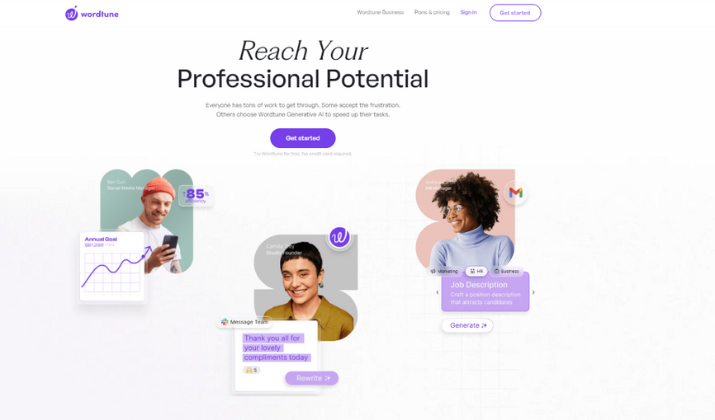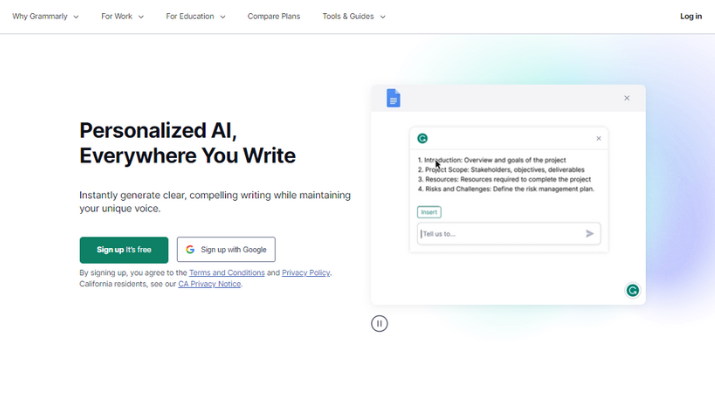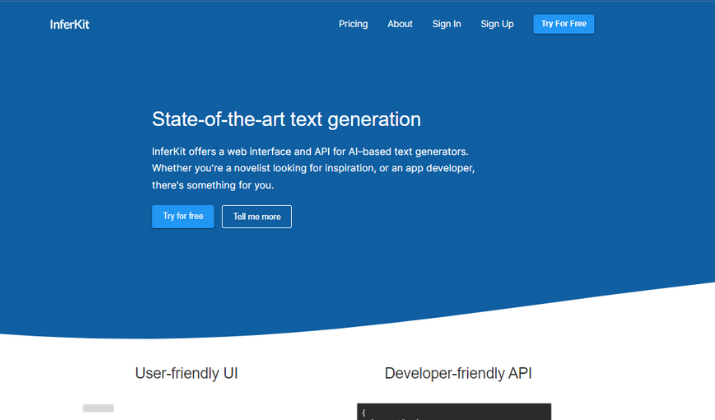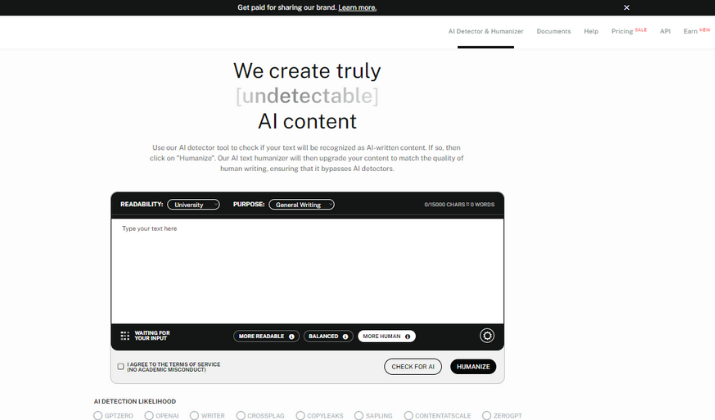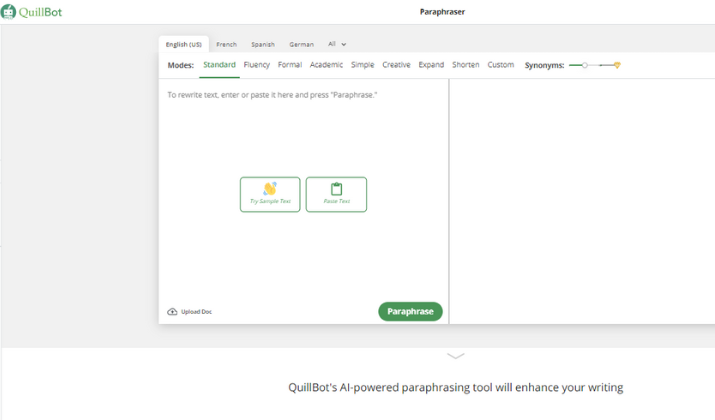I can’t deny how AI has made it easier for us to generate text in any form including blog posts, newsletters, social media captions, thesis, and marketing copies.
But even at that, you’ll be shooting yourself in the foot if you rely on the tool 100% and make zero effort to verify the authenticity of the information it provides or even add a human touch to the content.
I have seen a lot of people do this and it always backfires. AI-generated text will not have the same effect as humanized text and that’s because it usually appears too robotic and unnatural. Your audience will have a hard time relating to the message.
By humanizing AI-generated text, you’re going the extra mile to make your content more authentic and relatable. You can include links to information sources especially if you’re working on content like news, research papers, or any other authoritative text.
Additionally, you can lace the content with experienced stories that will resonate with your readers. All in all, humanizing AI-generated content helps to strengthen its reliability and authenticity.
In this article, I am going to show you how best to humanize an AI text and the tools you can use to achieve that. So, make sure you read to the end.
Without further ado, let’s dive right in!
7 Ways To Humanize AI Text
1. Strategic Editing
Image by Canva Studio via Pexels
One of the most effective ways to connect with your readers is to write in a more conversational tone. Your audience needs to feel that you’re interacting with them and AI will not give you this.
So, how do you tackle it? First, after AI reproduces any content based on the research you made, you should revise it and make the tone more conversational. That is, make it sound more like something a person would say or write.
You can rephrase some of the sentences and make them less formal. You should also remove overly technical or robotic language and add elements like contractions to mimic natural speech patterns.
A good example, use “I’m” instead of “I am.” You can also use transition words or phrases to ease into sentences. They help to smoothly connect your thoughts between paragraphs and sentences without abrupt changes.
Examples of transition words and phrases include, “Additionally”, “Besides”, “In addition to that”, “More so”, “What’s more”, “Furthermore”, “Lastly”, and a host of others.
The goal is to make sure that your readers can engage with the content as if they are having a conversation with you. It creates a better lasting impression than having them read machine-generated content.
Another way to strategically edit your text is to simplify complex words and language. I have noticed that AI mostly generates content with overly complex vocabulary and jargon that I even struggle to understand sometimes.
So, if I’m struggling to understand it, chances are that my readers may find themselves in the same shoes. A better approach is to break down these complex words and ideas and replace them with simpler and more common alternatives.
This way, the content becomes more inclusive and accessible to a wider range of readers.
Also Read: Best AI Story Generators
2. Storytelling Techniques
Image by Artem Podrez via Pexels
Let’s face it, humanity is built on stories. We may not remember facts and data but we certainly do remember stories better.
Even in high school, the teachers who tell more stories unconsciously become our favorite. We look forward to their classes because they are always memorable. Surprisingly, we hardly forgot their teachings.
That’s the power of stories especially when they are embedded within a message. People are more likely to recall and share it with others.
Stories also evoke emotions like empathy, excitement, or inspiration, making it easier to connect with your readers on an emotional level. This emotional engagement often leads to a stronger and more lasting impact.
In addition to that, people may hardly understand complex ideas or concepts. But when you illustrate them with relatable examples and stories, they will instantly grasp and retain the information.
Overall, stories hold the attention of your readers. Infusing them to AI-generated content is a great way to make your content more engaging and relatable to your audience.
You can start by including personal stories, anecdotes, or your experiences in the content. You’ll connect more with your readers as well as build trust and credibility.
People are more likely to respect and believe content that feels like it’s coming from a real person with real experiences than someone who just presents factual information.
Aside from stories, metaphors and analogies also help to humanize AI content. These are great storytelling tools that you can use to clarify complex concepts or ideas and make them more relatable and understandable.
For example, a statement like, “Writing this article was as easy as pie” suggests that it was very easy to create the content, similar to how eating a piece of pie is typically considered a simple and enjoyable task.
So, it’s like creating mental images and giving illustrations that help readers grasp abstract or unfamiliar concepts. You do this by relating them to something they already know or understand.
Also Read: Can Grammarly Detect ChatGPT?
3. Emotional Intelligence
Image by Andrea Piacquadio via Pexels
One of the questions I ask myself before writing any content is, “How are my audiences feeling at this point?” Analyzing their needs and emotions helps me to tailor my content such that it relates to their pains.
For instance, if I’m creating a health and fitness blog article targeted at stay-at-home moms looking to stay fit, I can tell better stories that will resonate with them because I understand their pain points.
AI will not do this work for you. That’s why it’s essential to always have a deep understanding of the emotions and needs of your target audience before writing. This requires analyzing the demographics, psychographics, and historical data of the audience.
As much as AI can be trained to recognize emotional cues from user interactions, you still need to work with real-time comments and feedback from people.
It helps you create content that resonates with readers on a personal level. You can tailor the tone, style, and message to match the emotional context of the audience.
Also Read: How To Write a Good Conclusion For Your Writing Project?
4. Varying Sentence Structure
Image by Buro Millennial via Pexels
If you pay attention, you’ll notice that AI-generated content is always repetitive and lacks rhythm. No wonder, it sounds so robotic and hardly connects.
To combat this, it’s best to vary the length of your sentences. Remember, in natural human communication, we use a mix of long and short sentences. This helps to retain the reader’s interest and also adds a certain kind of rhythm to your content.
While you use long sentences to give detailed explanations or elaborate more on a topic, short sentences can be used to make important points or emphasize key pieces of information.
You should also use synonyms or better still rephrase sentences to ensure that there is no repetition in your content. Let me give you an example:
Here’s a sample of AI-generated content with repetitive patterns: “The product is high-quality. It has a durable build. It is designed for long-lasting use. You will find it reliable. It is a great investment.”
You can rewrite it as follows: “Our product has exceptional quality, with a durable build designed to last a long time. This reliability makes it worth your investment.”
As you can see, the second sentence sounds way better, more natural, and more engaging than the first.
Check Out: Best Speedwrite Alternatives
5. Informal Language and Contractions
Image by Keira Burton via Pexels
Another interesting way to humanize AI-generated content is to use informal language and contractions. They will make your content sound more casual like how humans naturally speak and communicate.
A good example of contractions is using “can’t” instead of “cannot.” or using “I’m” instead of “I am,” or “You’ve” instead of “You have.”
I think incorporating these in your sentences make your content less formal and more like you’re chatting with your readers or having a conversation with them.
This is one of my favorite ways of humanizing AI-generated content. Perhaps it’s because my writing style is less formal. Whenever I’m writing, I imagine that my readers are seated before me and I’m addressing them.
You can also mimic natural speech patterns to add a human touch to your AI text. For example, we often use slang, colloquialisms, or idiomatic expressions in our everyday conversations.
Infusing these elements into AI-generated text makes it resonate better with your readers. Here’s another example, “It is not possible for the weather to improve tomorrow, as the meteorological conditions indicate continued precipitation.”
The informal version could be something like, “The weather can’t get better tomorrow. It’s gonna keep raining.”
As you can see, the use of contractions like “can’t” and “gonna” makes the sentence sound less robotic and more like something an actual person might say in a casual conversation.
However, bear in mind that this approach highly depends on the type of content you’re writing. If it’s formal content like a school thesis or academic journal, you might want to refrain from using a lot of contractions.
Also Read: How To Write An Argumentative Essay?
6. Humor & Wit
Image by Andrea Piacquadio via Pexels
Humor is such a powerful tool for engaging readers and making content more relatable and enjoyable. People love having a good laugh while reading any content.
Some time ago, I remember bookmarking a website because most of the articles made me laugh a lot. I fell in love with the platform and would constantly check back to see if they had published a new article. And the best part is that their content was highly informative.
That’s the power of infusing humor and wit into your work. AI might not get this done for you. So, you have to go the extra mile to include it seamlessly in your content.
It helps to create a positive emotional connection and encourages readers to interact with the content. Bear in mind that while humor makes your content entertaining, it’s essential to strike a balance between being witty and maintaining the informative value of the text.
Try as much as you can never to allow the humor to overshadow the content. It should enhance it.
The goal is to make the information more accessible and memorable while still conveying the intended message or information.
7. Visuals & Formatting
Image by Ketut Subiyanto via Pexels
Creating content over the years has opened my eyes to the power of visual elements like images and graphics, especially in this age and time when people’s retention rate is low.
Having walls of written content without complementing it with images might bore your audience. You want them to not only digest the information but also connect with it.
AI doesn’t offer this. So, it’s your job to source images that illustrate your points and keep the reader hooked.
Don’t forget to properly format your content for readability and engagement. You can use headings, subheadings, and bullet points to make your content more organized and easy to read.
Additionally, you want to use adequate white spaces between paragraphs and sections to make the content more readable. If you fail to do this, your audience might get overwhelmed.
I also noticed that callout boxes, quotes, and highlighted text also help in drawing attention to key points, making the content more interesting and memorable.
Overall, the aim here is to properly format your text so it engages your readers.
Also Read: Best Summarizing Tools Without Plagiarizing
Best Tools To Humanize AI Text
Now that we know the different techniques for humanizing AI-generated content, let’s now look at the tools that can help us achieve this seamlessly. I’m going to review some of the best tools and how you can use them to humanize AI text.
So here we go!
1. GPT-4 by OpenAI
Isn’t it interesting that AI outwits an AI? GPT-4 is an advanced language model developed by OpenAI. It is designed to write like a human as long as you feed it with the right information. Aside from producing more natural-sounding text, it can also process images.
Of course, it’s not a free tool. It’s available for $20 a month.
2. Wordtune
I think Wordtune is fascinating. It helps you write faster by offering AI suggestions to improve your choice of words and sentence structure while also preserving your unique writing style.
The best part is that you can include facts/statistics and even humor to make your content more human-like. You also don’t have to worry about grammar or spelling errors. Wordtune has all that sorted and will elevate your status as a professional writer.
There’s a free plan to get you started. But if you want to access more features, you can also subscribe to the paid plan.
3. Grammarly
If you want a writing tool that will help you detect spelling, grammar, or punctuation errors. It also helps to review your work for clarity and engagement and provides suggestions to enhance sentence structure.
Additionally, the tool allows you to customize your writing style and tone. You simply need to input the AI-generated text and have it run all the necessary checks.
To access all these features, you need to subscribe to the premium version.
4. InferKit
InferKit is such an interesting platform specially created for story and poetry lovers. This text-generation tool takes your text and predicts the sentence that should come next.
It’s quite a versatile tool that can also be used by marketing teams. You can create text of different lengths on nearly any subject.
The basic plan costs $20 per month.
5. Undetectable.ai
This is my favorite writing tool. In as much as it helps to detect AI-generated content, you can upgrade the text to sound more human-like by clicking the “Humanize” button. It’s such an easy tool to use.
Even as it switches your content to match the quality of human writing, it can never be detected by other AI detector tools. How amazing! And it’s free to use!
6. QuillBot
QuillBot is a paraphrasing tool that scans your text and not only detects spelling or grammar errors but also suggests synonyms to rephrase your sentence, paragraphs, or even the entire text.
This means that you can rewrite AI-generated content with the suggested synonyms. You only need to click on the word or sentence you want to paraphrase and watch it do the magic.
The tool is absolutely free to use.
Explore the best Quillbot Alternatives here.
Conclusion
The world is growing and AI has come to stay. The best we can do is to accept it with open arms. It doesn’t take away our creativity but rather makes our jobs easier and faster.
However, we must try not to rely on it wholeheartedly to do our work. No matter how much data you feed an AI tool, it’s still a machine and can never replace human experiences.
You need those experiences to connect with your readers. So, as much as it’s okay to embrace these tools, it’s also important that the writing still sounds like a person wrote it.
You should infuse humor, wit, contractions, and stories into your content. That way, you can connect with your readers better.
Cassie Riley has a passion for all things marketing and social media. She is a wife, mother, and entrepreneur. In her spare time, she enjoys traveling, language, music, writing, and unicorns. Cassie is a lifetime learner, and loves to spend time attending classes, webinars, and summits.








